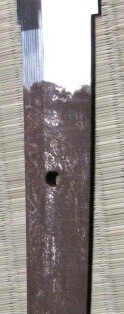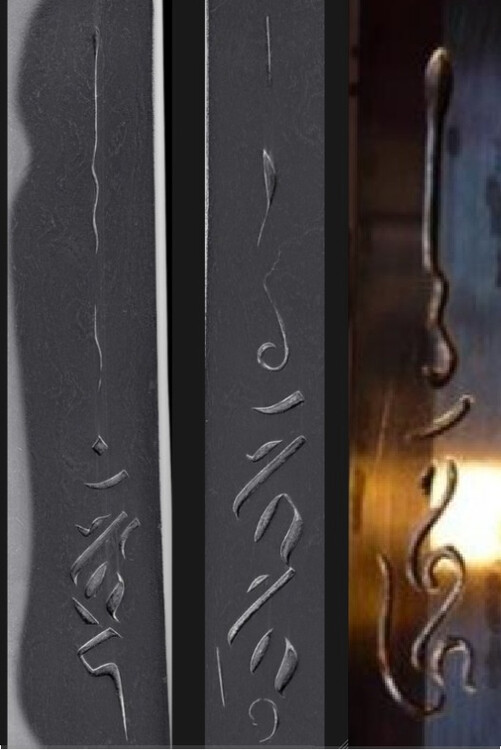-
Posts
779 -
Joined
-
Days Won
1
Content Type
Profiles
Forums
Events
Store
Downloads
Gallery
Everything posted by reinhard
-
If you say so. reinhard
-
I wonder who that strange creature in the back may be? It looks like a bald, giant lady in an old-fashioned swimming-suit. Any explanations? reinhard
-

Shinsakuto ...... are they Nihonto?
reinhard replied to sanjuro's topic in General Nihonto Related Discussion
Lee, There was no "official tatara tamahagane" used, when Ko-Hoki YASUTSUNA made his swords, but they are genuine NipponTo beyond all doubt. There was no "official tatara tamahagane" used, when Echizen YASUTSUGU smiths experimented with namban tetsu, but their swords are genuine NipponTo without question. There was no "offficial tatara tamahagane" used, when Suishinshi MASAHIDE made a sword out of links from the anchor-chain of a Russian ship, but he created a real NipponTo. There is "official tatara tamahagane" used, when Gassan SADATOSHI forges a blade by mixing tamahagane with old iron from Meiji-time teapots and the like. Their swords are all genuine NipponTo, because they were/are made by THE traditional technique (see: "the craft of the Japanese sword"). Raw material is judged by its quality only, not by its origin, and the place of manufacture is of no importance. The sword made by Gassan SADAICHI and his students in Boston's museum of fine arts in 1982 is a NipponTo at its best, no matter where it was made. On the other hand: Just taking any kind of steel and shaping it into a "traditional Japanese-looking blade" the easy way is not NipponTo. No matter if it was done by a Japanese person or not and no matter if it was done within the actual boundaries of Japan or not. The result was, is and will be just a poor look-a-like. Collectibles for lovers of militaria without any deeper sense for the unique quality of real NipponTo. ShinSakuTo made by licensed smiths therefore ARE real NipponTo. Much more than any Koa Isshin "katana", made and used for decapitating prisoners of war or any other oil-quenched hook made in Japan dating from the 1940ies. reinhard -
To speak it out loud: Rust and patina of the nakago are overlapping the freshly polished area of this blade. Old swords polished anew don't look like this. Meaning: This is probably a brand new sword not much older than its polish, but it was made to look much older. - I wonder what you have been told when buying. reinhard
-
Agree. It was most often Fudo Myo-O invocated by bonji on Japanese sword-blades and this might be the case here as well. But what a poor attempt it was. For consideration: reinhard
-
Don't worry. It says "Fune" for sure. reinhard
-
From a distance this hori-mono looks like a (naga-) bonji, but which deity is meant here? - Guido's other examples are quite clear and easy to understand in contrast to this one. reinhard
-
I can't see any kind of bonji here, not even a stylized one. reinhard
-
-

Hizen no kuni ju Tadamitsu
reinhard replied to Jeffrey Ching's topic in General Nihonto Related Discussion
According to Iimura's ShinTo Meikan there was a TADAMITSU working in Hizen during Kambun-era, but I agree with Paul: Nakago and mei are looking bad and unlike Hizen-style. reinhard -
No, it's not. Jacques gave you the hint, but you wouldn't listen: KAGEMITSU never signed his blades on tachi-ura. Your "bargain" is just a waste of money. You might learn something about very poor gimei though. reinhard
-
I don't have an agenda. I'm watching and laughing from a distance by now. You are trying to put me in the elitist cache for reasons I can only guess, but you are wrong. How to oil a NihonTo properly is not an advanced subject, but some outrageous advice has been given in the past (probably by militaria collectors still guessing if the yakiba on their ShinGunTo is oil-quenched or traditionally hardened). You are right: It's not rocket science. But it isn't anything goes either when it comes to genuine NihonTo. Helping beginners (with non-commercial intentions) is about the only thing I have ever cared about on NMB, for advanced discussions are not taking place on public fora anyway and I have stopped searching for them years ago. It is your job to protect beginners from sharks, vultures and silly advice. Can you? Almost everything beginners need to know can be found in two or three good books. They will cost them a small fracture of the amount of money some of them are willing to spend on ugly junk they find in the bay or elsewhere and these books can be delivered almost all over the world. What do you do with people acting against all friendly advice? Exactly. You give them comfort and solace, discussing their mistreated katana-like objects at length on the basis of a few bad pics. reinhard
-
This came to my mind as well, but then: There are different answers to the same questions in different threads. Some of these answers, though utterly wrong, have never been contradicted yet. - Who's going to supervise the self-declared "experts" and their "universal and final advice" on NMB? With all due respect, NMB's collective knowledge is far from being capable of establishing reliable guidelines and this is not necessary either. Most of what beginners must know has been written down before and/or can be found on decent sites. If someone's not willing to spend a minimal amount of money on a few good books and time to read them, he should be left by himself (and the bay) and learn it the hard way. These books and sites should be recommended, but this is where problems already start: Some of us are recommending certain books and others are contradicting. - Even if we were able to agree on reliable sources of information (which we are obviously not) differences of interpreting them will remain. Establishing a lighthouse, containing the "collected wisdom" of NMB, would just lead to more confusion and to a false feeling of safety for newbies. Better leave it as it is and try to hire the best mods you can get. reinhard
-
It's MASAHIRO actually, but it doesn't really matter anymore. reinhard
-
It says: Showa meibutsu (as in: "meibutsucho") Whatever that's supposed to mean here. reinhard
-
"Gorin" is not a name but part of the measurement. Rin is the tenth part of bu and "go rin" therefore meaning: "five rin" (in length). I've never heard of a Japanese family punished with a name like that. reinhard
-
There may be one or two ways of squeezing some kind of sense out of this "mei", but that's not the point. A poorly executed and unprecedented "signature" like this, mumbling of family treasure, wholehearted strength (and so on) on a messed-up sword like this should leave you with only one conclusion: A person unfamiliar with the history and tradition of NihonTo tried to increase the value of a sorry blade by adding some pseudo-importance to it. Unfortunately a poor fraud like this seems to be still working. Be warned, my little Hobbit-friends. Deceptions of a much more clever kind are waiting for you and your purse out there. reinhard
-
Voila. It wasn't that difficult, was it. reinhard
-
Jean, Shyly I dare to compete with Morita-san's skills. My version of the wakizashi-mei would be: - isshin (as in Koa Isshin), meaning: "wholeheartedly, with all the strength of my heart" - chikara, meaning: strength, power (just in case you haven't noticed yet) - the fourth character is tricky to translate, for I haven't seen it on mei yet. I'll call it "Wilson", because it reminds me of the volley-ball in the movie "cast-away" (with Tom Hanks) after things started growing out of it. - Yu, meaning: "male, brave, great" meaning/translation therefore is: "wholeheartedly strength (Wilson) brave" I'm sure Stephen wants to check the delicate habaki-moto area in hand in order to evaluate the straight transition-line between polished area and nakago. The shape of the blade reminds me of late Heian/early Kamakura-period examples, where the blade is tapering abruptly towards the point and curvature seems to "bow" towards the top. Good reason to check it carefully; not to forget the excellent carving of the mei. Sorry, forgot to take my meds against sarcasm. reinhard
-
Remnants of a mei are visible on the sashi-omote of the blade. Telling by the pics is difficult. reinhard
-
According to Mr.Robinson's inventory of the Baur-collection there was an unrecorded fitting-maker by the name of Yokoya TERUYUKI working in Edo during 19th century. Signature and especially Kao look quite different though. reinhard
-
It was a mozo (imitation) blade he received (see pic). Obviously for good reasons. But that's not what it is all about. Handling a katana in public in Japan is different from doing so in the rest of the world; no matter what kind or quality it is. To most Japanese people every katana is like a loaded gun. It has to be treated with utmost respect and it's better to stay away from it. This attitude might also explain the reaction of the Japanese ambassador described by Mr.Skebo. - BTW, the ceremony started according to protocol. reinhard
-
Thomas, We probably agree in most points except for it's being a bakumatsu-period work. Overall quality of this koshirae is just not up to minimal standards of that time. Even objects for everyday use were made more carefully during Tokugawa-period; not to speak of samurai's most valuable possession. - Anyway, I didn't mean to "argue". I'm sorry if my replies were understood as a kind of "argument". This particular tsuba is not worth it. reinhard
-
Things haven't changed much in the meantime. Nobody told Tiger about etiquette or protocol when he was presented with a NihonTo in 1997 in Japan. reinhard











